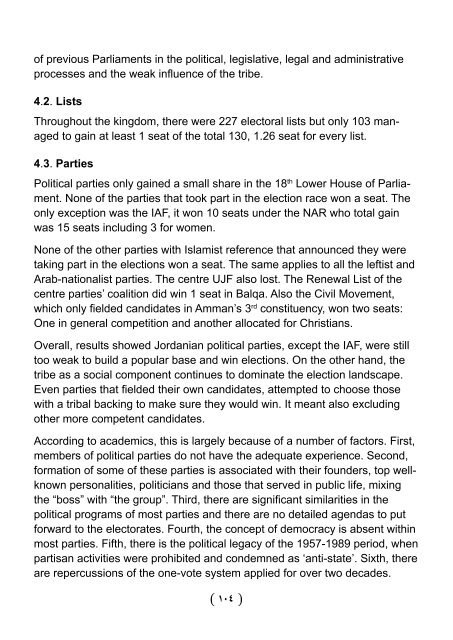الانتخابات الاردنية 2016
Jordan’s General Election of 2016
Jordan’s General Election of 2016
Create successful ePaper yourself
Turn your PDF publications into a flip-book with our unique Google optimized e-Paper software.
of previous Parliaments in the political, legislative, legal and administrative<br />
processes and the weak influence of the tribe.<br />
4.2. Lists<br />
Throughout the kingdom, there were 227 electoral lists but only 103 managed<br />
to gain at least 1 seat of the total 130, 1.26 seat for every list.<br />
4.3. Parties<br />
Political parties only gained a small share in the 18 th Lower House of Parliament.<br />
None of the parties that took part in the election race won a seat. The<br />
only exception was the IAF, it won 10 seats under the NAR who total gain<br />
was 15 seats including 3 for women.<br />
None of the other parties with Islamist reference that announced they were<br />
taking part in the elections won a seat. The same applies to all the leftist and<br />
Arab-nationalist parties. The centre UJF also lost. The Renewal List of the<br />
centre parties’ coalition did win 1 seat in Balqa. Also the Civil Movement,<br />
which only fielded candidates in Amman’s 3 rd constituency, won two seats:<br />
One in general competition and another allocated for Christians.<br />
Overall, results showed Jordanian political parties, except the IAF, were still<br />
too weak to build a popular base and win elections. On the other hand, the<br />
tribe as a social component continues to dominate the election landscape.<br />
Even parties that fielded their own candidates, attempted to choose those<br />
with a tribal backing to make sure they would win. It meant also excluding<br />
other more competent candidates.<br />
According to academics, this is largely because of a number of factors. First,<br />
members of political parties do not have the adequate experience. Second,<br />
formation of some of these parties is associated with their founders, top wellknown<br />
personalities, politicians and those that served in public life, mixing<br />
the “boss” with “the group”. Third, there are significant similarities in the<br />
political programs of most parties and there are no detailed agendas to put<br />
forward to the electorates. Fourth, the concept of democracy is absent within<br />
most parties. Fifth, there is the political legacy of the 1957-1989 period, when<br />
partisan activities were prohibited and condemned as ‘anti-state’. Sixth, there<br />
are repercussions of the one-vote system applied for over two decades.<br />
) 104 (


